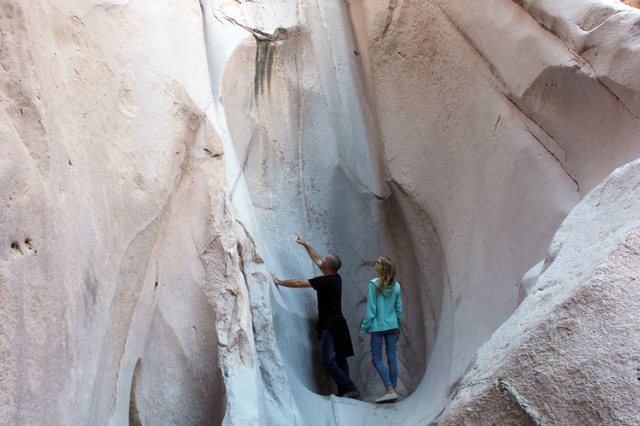Keyhole Canyon holds archaeological treasures
Not far from the urbanized Las Vegas area lie desert, canyons and mountains nearly as untouched by development today as when pioneer settlers first arrived in the area. Discovering some of the interesting places that are tucked away in Southern Nevada is one of the joys of living here.
Keyhole Canyon, a steep-walled box canyon south of Railroad Pass off U.S. Highway 95, harbors ancient rock art and offers challenging rock-climbing routes.
To reach Keyhole Canyon, follow U.S. Highway 93/95 south to the junction at Railroad Pass. Turn toward Searchlight and Laughlin on U.S. 95. You will be skirting the dry lakes in Eldorado Valley, where extensive solar generating fields have been installed.
Travel 15 miles from the junction, passing the turnoff to old Nelson and Eldorado Canyon. Watch for an unmarked turnout in the divided highway about 5 miles south of the turnoff to Nelson. Take care crossing the northbound highway lanes to turn right on a gravel road heading east from U.S. 95. This is a somewhat washboarded route with a few sandy spots and rocky patches, so it’s best traveled in a vehicle with some ground clearance. Drive slowly and carefully to avoid kicking up dust.
Follow the gravel road 2.2 miles from the highway, passing under a set of power lines, where you will turn right again and head south. The road will take you 1.8 miles, crossing a couple of washes. Turn left on the short spur road to Keyhole Canyon, which should be marked. You will reach a rustic fence at the base of some hills that keeps the area closed to all but foot traffic.
Park in the area cleared by the Bureau of Land Management. There is enough room for a few cars and a turn-around area. A vault toilet has been installed at one edge of the parking area. There is no water available at the site, so bring enough water from home for drinking and extra for vehicle emergencies. The area is handy for tailgate picnics, but plan to take all refuse home for disposal.
Two parallel fence sections form a gateless access to a trail into Keyhole Canyon, a means of protecting the archaeological site from motorized approach. Follow the pathway to the canyon’s entrance. Erosion has worn away some of the petroglyphs incised into rock faces near the mouth of the canyon. Crafted by native people centuries ago, the rock art indicates a place that was significant to those early visitors to the site.
A gravel-bottomed gorge extends several hundred feet back into the mountain, walled by rocky cliffs. On tumbled boulders and rock slabs, more rock art survives in the canyon with a variety of petroglyphs, a few pictographs in ochre-red paint and a scattering of capsules, enhanced circular depressions in the stone. Photograph the ancient handiwork, but avoid degrading the rock art by touching it or climbing on it. Climbing routes in the canyon keep clear of the rock art.
About midway into Keyhole Canyon, visitors must slide carefully over a huge wedged boulder to reach the upper end of the canyon. The canyon ends where a dry waterfall drops vertically from above. At the base of the waterfall, a rocky basin holds runoff water for a few days after storms.
Familiar with places where the unforgiving desert environment provided water, the ancient native people would have relied upon the intermittent resource in Keyhole Canyon as they hunted and gathered in the vicinity. They might have enhanced the rock basin at the base of the waterfall. Even without water, the canyon provided shade, cooler temperatures, shelter from wind and storms and a defensive position. Some of the blackening seen in the canyon may be from campfires where nomadic travelers gathered centuries ago.
Margo Bartlett Pesek’s Trip of the Week column appears on Sundays.























